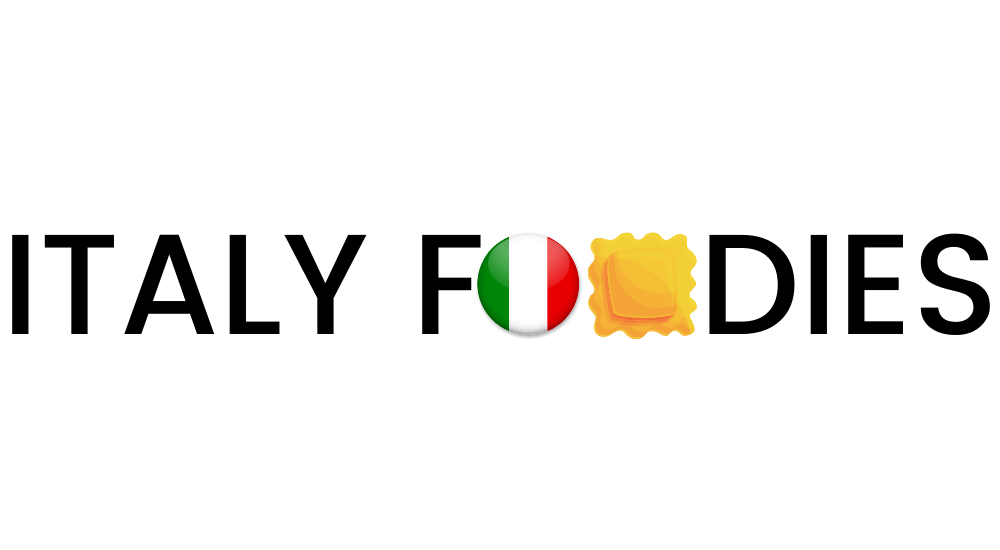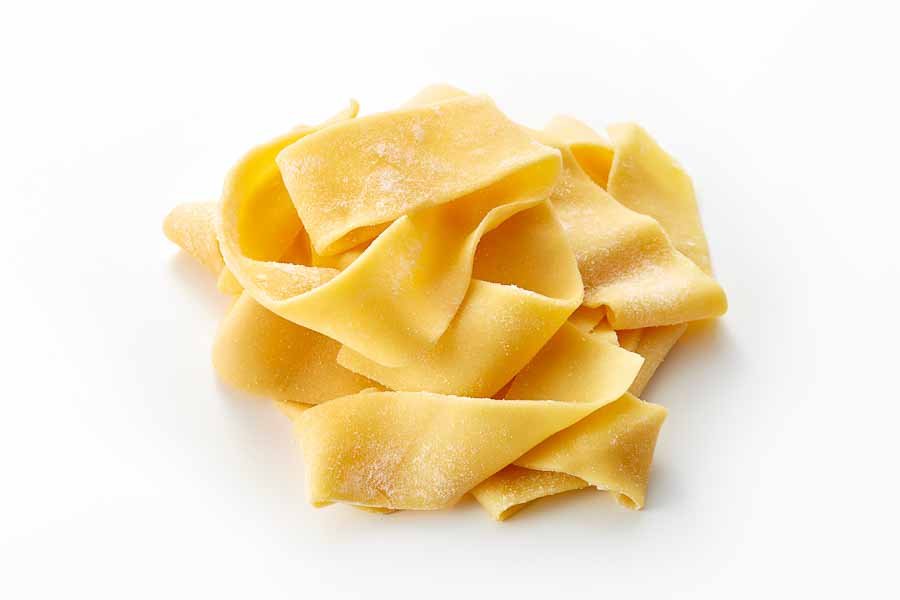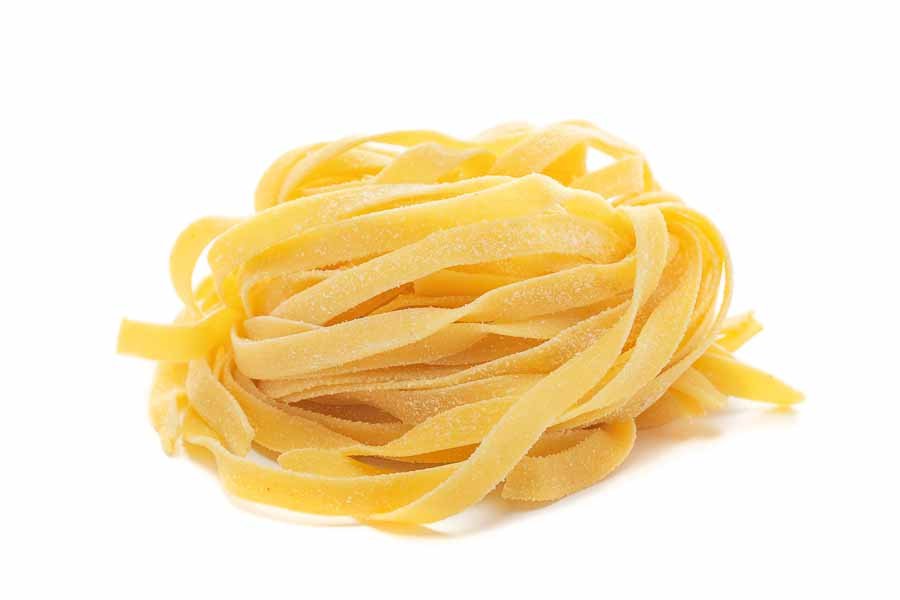Tagliatelle vs Pappardelle: What’s the Difference?
If you love egg pasta and wide noodles that really hold the sauce, then you likely have a love affair going with pappardelle. Or is it tagliatelle you love? Wait, no, is it… fettucine?
It might seem fickle, but they’re the practically the same noodle, right? Well, not exactly. So let’s talk about tagliatelle vs pappardelle!
For the uninitiated, pappardelle and tagliatelle can be hard to tell apart. Both are ribbon pastas that are popular in Italy, but most widely found in just a few areas.
So what exactly are pappardelle and tagliatelle and why do they require an entire blog post to explain the difference between the two?
Well, here’s a fun Italian food fact for you: the average person in Italy may eat more than 51 pounds of pasta every year, but 24% of the global consumption of pasta is by Americans – the largest of any country in the world!
Clearly, pasta is important stuff for Italy food lovers, and we want to know our noodles!
What’s in this Article?
Tagliatelle vs Pappardelle: What’s the Difference?
How are Pappardelle and Tagliatelle Similar?
Typical Dishes with Pappardelle and Tagliatelle
How to Make Pappardelle and Tagliatelle
What’s the Difference Between Pappardelle and Tagliatelle?
The biggest difference between tagliatelle vs pappardelle is its width.
Pappardelle noodles are slightly wider than tagliatelle.
Other than the size (width) of the noodles, the other main difference is the region of Italy in which they’re most often found. If you’re eating pappardelle, chances are you’re somewhere near Tuscany.
If you have a plate of tagliatelle, you’re likely around Bologna or Modena in Emilia Romagna, or in the Marche region.
Yes, Italians are rightly proud of their regional food specialties in Italy and prefer them over those of the surrounding regions.
Tagliatelle vs Pappardelle
What is Pappardelle?
Pappardelle (pronounced pop-ahr-dell) is a wide ribbon-like noodle ranging in width from 3/4“ to just over an inch (2-3 cm) depending on who’s doing the cutting.
The name pappardelle comes from the Italian pappare, which means to gobble up or wolf down — and we guarantee you will.
Pappardelle noodles originated in Tuscany, and you’ll find them served with rich and meaty sauces — the noodle’s width balances out the rich flavor — that are usually tomato and meat-based from beef, pork, lamb, or poultry.
A big difference in pappardelle vs tagliatelle is the flour that is used. Many chefs and recipes call for using 00 flour when making pappardelle.
00 flour, like semolina flour, is made from durum wheat but is much finer, which makes for a softer pasta.
What is Tagliatelle?
Tagliatelle (pronounced tal-ya-tell) is one of the most famous pastas in Emilia Romagna and they’re also found in Marche.
The name derives from the Italian verb tagliare, which means to cut, and watching homemade tagliatelle being made and cut is some of the most fun you can have on a slow travel tour in Emilia Romagna.
Even though pappardelle is Tuscan and tagliatelle is mostly found in Emilia Romagna, we once found the line of demarcation for pappardelle on a road trip through southern Emilia Romagna at a fantastic Italian ristorante near Lake Suviana. Ristorante Luana has incredible food!
But when I mistakenly called my dish tagliatelle, Luana was quick to correct me that it was pappardelle… they were after all, practically in Tuscany!
Tagliatelle is not as wide as pappardelle and ranges from just over 1/4” to just under 1/2” wide (6-10 mm), making it very close to the width of fettuccine. In fact, tagliatelle makes a great substitute for fettuccine, or vice versa.
Tagliatelle a less egg-y than pappardelle with most recipes calling for only one egg per cup of flour.
Two good commercial versions of these pastas are made by De Cecco and Barilla come packaged as small flattened balls of dried flat noodles that resemble a bird’s nest. We’ve tried both and they’re an excellent alternative to homemade.
How are Pappardelle and Tagliatelle Similar?
The similarities between pappardelle vs tagliatelle make it easy to think it’s the same noodle. Some might even throw fettuccine in with the lot.
Tagliatelle vs fettuccine is yet another question to ponder, and let’s not even get started on the homemade “pasta rags” which could keep many an foodie guessing as to which category that falls into!
Both pappardelle and tagliatelle are egg-based pastas which narrows the field significantly as to which region you’ll most often find them.
While the ingredients are more or less the same, the most noticeable difference is in the different width of the two.
Both of these pastas are long, wide, and flat. But look closer at the width of the noodle, how its made and the region it hails from to find the answer.
Typical Dishes with Pappardelle and Tagliatelle
Pappardelle
Since pappardelle hails from Tuscany, you’ll find this noodle paired often with another Tuscan favorite, wild boar. If you haven’t tried Cinghiale — and you’re a carnivore — please do.
The typical Tuscan pasta dish, Pappardelle Cinghiale, is Tuscany’s most famous pig dish and it’s absolutely delicious.
We’ve had this many times, and other than a few differences in spices, it’s always hearty and filling.
Another favorite and hearty dish is Pappardelle with porcini mushrooms, a simple pasta dish made when porcini mushrooms are in season in the Fall.
The sauteed mushrooms are added to pappardelle with just a drizzle of olive oil.
Pappardelle Cinghiale (wild boar)
Tagliatelle
If there’s one dish that defines the city of Bologna and can be found just about anywhere in Emilia Romagna, it is Tagliatelle with ragú. Also known as Ragú alla Bolognese, this dish is traditionally made with beef, but can also be found with a combination of beef and pork.
The sauce is tomato-based with a traditional “humble beginnings” of celery, carrots, and onion (battuto or soffritto in Italian or mirepoix in French), and often red or white wine is added (surprise).
The meat sauce is slow cooked for hours then generously blended with the tagliatelle. This is Italian comfort food at its best!
Both pappardelle and tagliatelle pastas are easily interchangeable depending on what you’re making or what you have on hand — it really depends on how authentic and true to a recipe that you want to be. Just don’t tell our friends in Italy that we said that.
In Italy, where you are tells you which pasta you’re getting — if the cook doesn’t remind you first!
Tagliatelle with ragú Bolognese
How to Make Pappardelle and Tagliatelle
Without question the best way to enjoy pappardelle and tagliatelle is to have fresh housemade pasta in a good Italian restaurant or make it at home.
You can also try your hand at making it in a cooking class in Bologna or Tuscany. It’s some of the most fun a foodie can have!
Although both pappardelle and tagliatelle are available by major brands like De Cecco and Barilla, it’s simple to make pasta fresca at home.
Whether your dish calls for pappardelle or tagliatelle, you’ll find it easy and satisfying to make your own.
There are many flour variations you can use, but basically semolina, a good all-purpose flour, or a combination of both work well. Eggs are then added to the flour.
Some recipes call for up to two eggs per cup of flour.
After that, a bit of extra virgin olive oil and a good pinch of salt are the only other ingredients.
To Make Fresh Pasta:
To make fresh pasta:
Form a volcano shape with the flour then make a well in the middle.
Crack the eggs into the well along with the remaining ingredients.
Gradually blend the wet ingredients with the flour using your fingers or a spatula (it’s more fun with your hands) until a soft dough is formed.
It’s always a good idea to knead the dough for up to ten minutes to get the gluten going. This helps hold the shape of the noodles.
***
With more than 300 shapes of pasta, learning the difference between tagliatelle vs pappardelle or tagliatelle vs fettuccine is just scratching the surface. But knowing these two pastas will go a long way when visiting two of our favorite places in Italy — Tuscany and Emilia Romagna.
Buon appetito!






